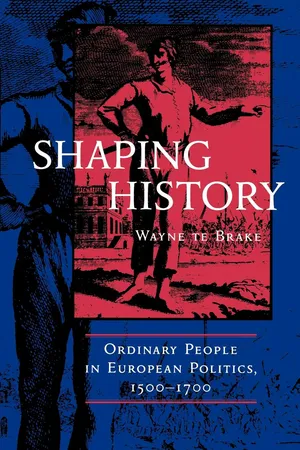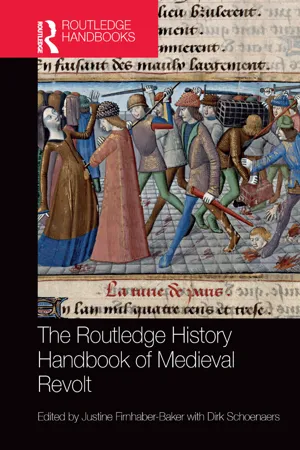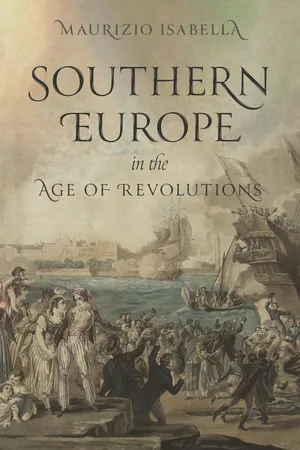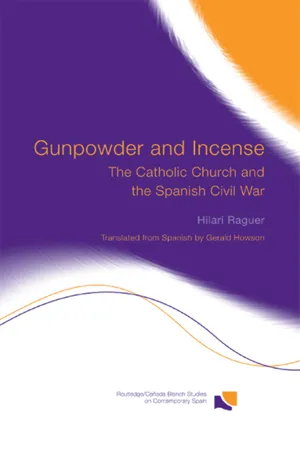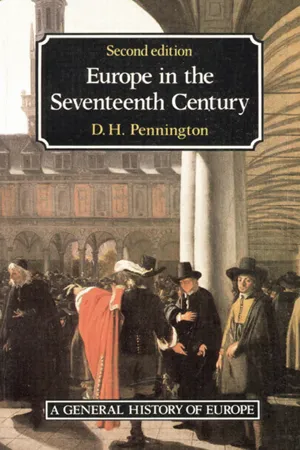History
Revolt of the Comuneros
The Revolt of the Comuneros was a rebellion in 16th-century Spain, led by citizens of the cities against the royal government. The comuneros sought to challenge the authority of King Charles I and assert their own rights and privileges. The revolt ultimately failed, but it marked a significant moment of resistance against the centralizing policies of the monarchy.
Written by Perlego with AI-assistance
Related key terms
Related key terms
1 of 4
Related key terms
1 of 3
5 Key excerpts on "Revolt of the Comuneros"
- eBook - ePub
Shaping History
Ordinary People in European Politics, 1500-1700
- Wayne te Brake(Author)
- 2023(Publication Date)
- University of California Press(Publisher)
As the events in Segovia suggest, however, the Comuneros’ opposition to the royal government involved as well a political realignment within the local community as officials appointed by and oriented to the royal administration were replaced by others who were more responsive to local demands and who were selected by, among others, the representatives of popular parish assemblies. And once they joined the Sacred League, the leaders of the rebellious communes of Castile deepened their political orientation toward ordinary political actors within the urban community by building the league’s defenses on the basis of urban militias mobilized and recruited locally. There is certainly more than a little historical irony in the fact that the Comunero Revolution adopted the defensive form of a sacred league because less than fifty years earlier, in 1476, Queen Isabella had encouraged the chartered cities in her Castilian domain to act as a sacred league—the Sancta Hermandad—and to raise urban militias to maintain public order and support her in her efforts to tame the powerful Castilian nobility. Though the league of cities had been disbanded in 1498, when the Crown once again shifted its dynastic policy toward dependence on the rural nobility, the lessons of this earlier political process had clearly not been lost on the municipalities involved. To deploy the civic militia in opposition to the new king, however, was to create a new kind of internal political dynamic that also entailed the creation of independent municipal councils, or “communes” (hence the name “Comunero”). For the duration of the revolt, at least, the local rulers of the rebellious cities were to be fundamentally dependent on the approval and support of their subjects (see fig. 2a).In the late summer of 1520, the political situation in Castile became even more volatile and threatening to the established political order when political disturbances in the countryside began to threaten noble landlords as well as the king. In the village of Dueñas, not far from the - Justine Firnhaber-Baker, Dirk Schoenaers(Authors)
- 2016(Publication Date)
- Routledge(Publisher)
13At the beginning of September, a wave of anti-seigniorial revolts broke out across a large part of the north and south of Castile. Initially, the Junta kept its distance from them.14 During the month of October, the royal army was raised, with the support of most of the Grandees, who had also not been involved up to that point, fearful of the uprisings spreading through their lordly estates. That same month, some of the cities, among them Burgos, Cuenca, and Soria, started to distance themselves from the political positions defended by the Junta, either because they were wary of the Junta’s draft proposals for transforming the political structures, or because the elites of those cities feared that their position of control over the local institutions of government was being challenged in the course of the revolt, which was exactly what was happening.15I shall not dwell at length on an account of the events, except to point out that the capture of Tordesillas by the royalist army on 5 December 1520 forced the Junta comunera to move to the nearby city of Valladolid, which became the capital of the movement from then on. After that, there was a succession of attempts at negotiation and military clashes, until the comunero army was finally defeated at Villalar on 23 April 1521.Map 17.1 The scope of the War of the Communities.The historiography of the War of the Communities of Castile: a critical review
There is an immense historiography on the War of the Communities of Castile, or the Revolt of the Comuneros, so I shall concentrate here on what I consider to be the central issues.16 Readings of the movement began not long after it ended. Most descriptions of it in the chronicles were dismissive in tone, although, in a few of them, there was a veiled and diluted sense of sympathy for some of the demands made by the comuneros. Finally, a third group of chronicles presented the conflict as a plebeian revolt and characterised it as a populist, anti-seigniorial movement.17- eBook - ePub
- Maurizio Isabella(Author)
- 2023(Publication Date)
- Princeton University Press(Publisher)
This uprising, centred in Catalonia, but affecting also the neighbouring provinces of Aragon, Valencia, the Basque country and Navarre, mobilised around thirty thousand individuals. Their social composition was interclass in nature, ranging from peasants to artisans. While the motivations of the day-labourers, artisans, clerics, guerrilla fighters and Voluntarios Realistas who joined this movement no doubt differed, the members of the armed partidas that rose up were agreed in demanding the reintroduction of the Inquisition and the ousting of the much-hated moderate members of the government. After 1824 anti-governmental protests against the had occasionally resulted in public demonstrations of support for the king’s brother, Don Carlos, as an alternative monarch. His sympathies with the demands of the ultra-royalists were well known, although the precise extent of his own active involvement in fomenting the royalist conspiracies of this period is difficult to establish. Public displays of support for Carlos remained isolated, however, and popular royalism (at least during this decade) never questioned the legitimacy of the existing king. What is striking about the revolt of the agraviados was that its participants claimed to have intervened to defend the royal prerogatives, considering the monarch to be a prisoner of freemasons and liberals. 41 As the participants of the eighteenth-century motines had done, its leaders demanded that the king act as a guarantor for their demands, a request that could only be satisfied in his physical presence. To reaffirm his authority and pacify the country, military intervention led by the Count of Espa ñ a was not sufficient: the king was once again required to travel across the country to re-establish a public bond with his subjects. This was clearly an effective strategy, since soon after the beginning of his tour the country was fully pacified - eBook - ePub
Gunpowder and Incense
The Catholic Church and the Spanish Civil War
- Hilari Raguer, Gerald Howson(Authors)
- 2007(Publication Date)
- Routledge(Publisher)
17Anti-communism?Anti-communism occupies the second place in the list of reasons offered by the rebels for the uprising. Most of the proclamations of the pronunciamiento mention the imminent danger of the ‘sovietization’ or ‘bolshevikization’ that was, according to them, threatening Spain. Yet in reality, when the war broke out the Communist Party of Spain could count on very few effective members. In the Cortes Constituyentes of 1931 there was not a single Communist deputy, in those of 1933 there was only one and in 1936, despite the triumph of the Popular Front, of the 473 deputies, only seventeen were Communist. Later, Francoist propaganda published, as one of the key items of the so-called ‘Legal Report on the Validity of the Uprising’, some documents which were supposed to prove that the Communists had been preparing a revolution for the spring of 1936. It detailed the horrible crimes that were being planned, which left the military no choice but to anticipate the revolution by a coup of their own. Today, however, all historians recognize the falsity of those papers. Southworth, simply by analysing the internal content of the documents themselves and by examining the inconsistencies found in successively published versions, demonstrated with irrefutable methodological rigour that they were an imposture.18 Even an author as Francoist as Ricardo de la Cierva, when he published Los documentos de la primavera trágica in 1967, thought it unacceptable to include those relating to the alleged conspiracy, and in a later work he even went so far as to ridicule the ‘foolish acceptance of these documents by numerous propagandists and even by some distinguished historians’.19 One of the secondary effects of this was precisely the empowerment of a Communism which, until then, had been almost non-existent. Four months into the conflict, the American ambassador wrote in one of his despatches, ‘This war is making communists’.20 - eBook - ePub
- Donald Pennington(Author)
- 2015(Publication Date)
- Routledge(Publisher)
10REBELLION
A large part of the history of seventeenth-century Europe is made up of violent resistance to authority. Rebellion at every level of society was as much a part of life as were famine, plague, and war. The word can be applied to events ranging from a local riot to a civil war; and efforts to define rigid categories have, as with many such words, led to forceful arguments but not to accepted conclusions. The simplest classification of rebellions depends on the people originally or chiefly involved. There were those among the aristocracy, often headed by rival claimants to a throne. There were those led by men of substance below the aristocratic level, such as French lawyers, English gentry, or the townsmen of Prague. And there were those of the urban and of the rural poor. It is more difficult to divide rebellions according to their purpose – to overthrow a central government, to establish local privileges, to secure the rights of a minority, or to remedy one form or another of oppression and poverty. The proclaimed objectives of a rebellion could change quickly and unpredictably: many participants must often have had only a vague knowledge of what they were. A popular rising could often be absorbed into, or originate from, a larger political movement. Which of those should be called ‘revolutions’ is another topic of massive argument. What is widely accepted is that any explanation of the outbreak of rebellion has to be sought in a multiplicity of circumstances. With each such event two separate questions can be asked – what were the backgrounds and aspirations of those who rebelled, and why at that time and place rather than another did they lead to violent action? When rebellions are looked at collectively far more complex questions arise, leading into the depths of historical and sociological theory. Only the surface of them can be touched here.REBELLION AND REVOLUTION
The 1640s and 1650s were an age of rebellions. Men said so at the time, and tried to interpret the warning of comets, explain the prophecies of the millennium, or calculate the average lifetime of empires on the assumption that some cataclysmic moment had arrived. It is tempting to point to the English Civil War (see pp. 460–9), the successful revolt in Portugal against the Spanish monarchy, and the less successful ones in Catalonia, Sicily and Naples (see pp. 388–97), to the peaceful overthrow of the Orange stadtholderate in the Netherlands (see pp. 469–75) and to the Fronde in France (see pp. 326–31), and to insist that the occurrence of all these in the space of ten years cannot be just coincidence. The great rebellion in the Ukraine in 1649 is less tempting to include; and if the revolts that in the same years overthrew the Ming dynasty in China are added the claim that they are all part of the same crisis becomes embarrassing. Even in western Europe, if the revolts formed a single event marking the watershed between the world of the Renaissance and that of the Enlightenment, or between a feudal and a capitalist society, it is remarkable how little they affected each other in their outbreak or course. It is a familiar fallacy to suppose that if revolutions occurred independently they ought to be evenly spaced throughout whatever period is discussed. If the Revolt of the Netherlands or the Bohemian rising, or the later troubles in Hungary had occurred in the forties, they too would naturally have been hailed as part of the great revolutionary upheaval. It has been pointed out that at least as many rebellions can be found in the 1560s.1
Index pages curate the most relevant extracts from our library of academic textbooks. They’ve been created using an in-house natural language model (NLM), each adding context and meaning to key research topics.
Explore more topic indexes
Explore more topic indexes
1 of 6
Explore more topic indexes
1 of 4
